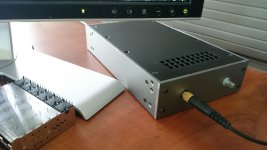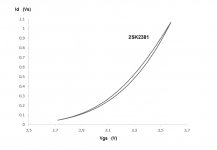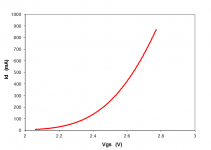Have you taken a look at the e5 schematic to see if there are any differences that may contribute to the noise perhaps?
If I recall, the grounding took a bit of expirimenting with my e5 at first, with a slight hum there.
I do not have a good schematic of the E19 (too lazy to create one from the board). The E19 used bigger filter caps (6800 vs 4700 uF) than the E5. But E19 missed the filter cap for the uPC1237 protection circuit which leads to leaking 120Hz hum to the output. Otherwise, the circuit topology is almost identical as reported by nattawa.
I added a 470 uF smoothing cap to the uPC1237 protection circuit power supply (E5 style). It significantly reduced the hum, but not eliminated it completely.
nattawa (post #10) mod the E19 circuit board to a clean "star-GND" where signal and power filter returns hook up straight to on their own wires. It seems to work well. And using a higher impedance phone seems to help too.
I will try adding a fully regulated power supply this week. I will report back how it works out for the HD598 (50 ohm impedance) phone.
Last edited:
You're right, Keilau. Aside from the missing little filter cap, the E19 PCB design suffers from a carelessly wired up GND system too, that means the 120Hz hum finds its way at more than one places into the signal paths. The ultimate solution would have to be what I did, by discarding all the PSU wiring and establishing a clean GND system, either on the existing board or by using an out-board PSU.
My son listening-tested the modded E19 with his pair of 55-ohm AKG K240S and a pair of Audio-Technica ATH-R70x (470-ohm but high sensitivity). There was no hum to report even with volume at maximum.
My E19 is now housed in a chassis I built with scrap aluminum pieces and is now sitting on my desk at work serving the purpose. I'll need to find a nice knob for it
My son listening-tested the modded E19 with his pair of 55-ohm AKG K240S and a pair of Audio-Technica ATH-R70x (470-ohm but high sensitivity). There was no hum to report even with volume at maximum.
My E19 is now housed in a chassis I built with scrap aluminum pieces and is now sitting on my desk at work serving the purpose. I'll need to find a nice knob for it
Attachments
...by the way, there could be more than one options when it comes to external PSU...check out THE SILENT SWITCHER developed by member Jan Didden. There is a THREAD going on with DiyAudio, too. With the SilentSwitcher you don't need a power transformer in the chassis anymore, as you will supply it with a USB charger or a suitable wall wart ac adapter.
...by the way, there could be more than one options when it comes to external PSU...check out THE SILENT SWITCHER developed by member Jan Didden. There is a THREAD going on with DiyAudio, too. With the SilentSwitcher you don't need a power transformer in the chassis anymore, as you will supply it with a USB charger or a suitable wall wart ac adapter.
It seems like an very interesting idea and may have a lot of future. But my conventional linear power supply including the toroidal transformer cost less than half of the Silent Switcher and can provide 8 time more current. It is also more compact.
The LPS I use has the 7815/7915 regulators which are even older than the LM137/337, but should perform adequately. I will see if the ground plate mod you did is still necessary.
Thank you for all the feedback you provided.
No, I will not recommend the E19 board. The ground loop is so poorly designed, it is not worth the effort to build a quality headamp.
It is a dilemma on what to use. Many of the Ebay offers sound good on paper, but need a lot of work to get the result out.
If I were to try again, I may pick one of the HA5000 clone. I did not try this and have no idea of its quality. But will be very interested in how much a DIYer can get out of it.
It is a dilemma on what to use. Many of the Ebay offers sound good on paper, but need a lot of work to get the result out.
If I were to try again, I may pick one of the HA5000 clone. I did not try this and have no idea of its quality. But will be very interested in how much a DIYer can get out of it.
A few comments, just stumbled into this by accident :
uPC1237 is meant for loudspeaker protection, and has a trigger point at +0.7/-0,2V.
One can decide whether it is high or not, but I guess most over-ear phones should survive 0.7V DC.
In any case some protection is better than none.
On 2SK2381 / 2SJ407, we got curious, bought some, and curve traced them.
They are one of the most horrible curves we have seen.
They were traced with a triangular wave form (linear current ram) at 100Hz.
So it is just normal operating condition.
You can see that the positive and negative swings followed completely different curves, with a huge hysteresis.
So that was end of story for us. The 5 pairs we bought went to the bin straight after.
You always get what you pay for.
Patrick
.
uPC1237 is meant for loudspeaker protection, and has a trigger point at +0.7/-0,2V.
One can decide whether it is high or not, but I guess most over-ear phones should survive 0.7V DC.
In any case some protection is better than none.
On 2SK2381 / 2SJ407, we got curious, bought some, and curve traced them.
They are one of the most horrible curves we have seen.
They were traced with a triangular wave form (linear current ram) at 100Hz.
So it is just normal operating condition.
You can see that the positive and negative swings followed completely different curves, with a huge hysteresis.
So that was end of story for us. The 5 pairs we bought went to the bin straight after.
You always get what you pay for.
Patrick
.
Attachments
On 2SK2381 / 2SJ407, we got curious, bought some, and curve traced them.
Thanks for sharing the interesting test data. I understood these devices are for switching mode operation by design, but did not expect the hysteresis threshold behavior. What is the range of Id in mA the test was done over? Would you mind posting the schematic of your test setup as well?
A few comments, just stumbled into this by accident :
uPC1237 is meant for loudspeaker protection, and has a trigger point at +0.7/-0,2V.
One can decide whether it is high or not, but I guess most over-ear phones should survive 0.7V DC.
In any case some protection is better than none.
On 2SK2381 / 2SJ407, we got curious, bought some, and curve traced them.
They are one of the most horrible curves we have seen.
They were traced with a triangular wave form (linear current ram) at 100Hz.
So it is just normal operating condition.
You can see that the positive and negative swings followed completely different curves, with a huge hysteresis.
So that was end of story for us. The 5 pairs we bought went to the bin straight after.
You always get what you pay for.
Patrick
.
Were you able to compare 2SK2381/2SJ407 pair from US distributor? Were you able to verify that the units you got were NOT line rejects?
The 2SK2381/2SJ407 are good devices and standard units should not behave the way you measured. I am not sure what the source of the problem is, but suspect defective line rejects sold by Ebayer.
> The 2SK2381/2SJ407 are good devices ...
If you say so.
Cheers,
Patrick
It doesn't matter what I said. Toshiba has been making MOSFET for a long time. Yes, the 2SK2381/2SJ407 are not the proper pair and they may not be the best choice for audio output devices. But your test result looks very unusual for Toshiba device that I used.
Get some 2SK2381/2SJ407 from Digikey for your test. It is not fair to treat fake products from Ebay as the genius part.
You always get what you pay for.
I can't agree more with you on this.
Last edited:
It looks like the original version of this amp is available once again;
http://diyhifishop.com/new-assembled-board-e5-class-a-headphone-amplifier-alps-rk27-diy-p-216.html
The site was pretty dim a year or two ago, with nothing showing available, however it looks like that has changed...
http://diyhifishop.com/new-assembled-board-e5-class-a-headphone-amplifier-alps-rk27-diy-p-216.html
The site was pretty dim a year or two ago, with nothing showing available, however it looks like that has changed...
It looks like the original version of this amp is available once again;
http://diyhifishop.com/new-assembled-board-e5-class-a-headphone-amplifier-alps-rk27-diy-p-216.html
The site was pretty dim a year or two ago, with nothing showing available, however it looks like that has changed...
How do you know that they are active again?
The upgrade with a regulated PS is finished. I used a simple pair of L7815/L7915. The picture show the stock form PCB vs. the modified PCB for the regulated PS. There are 4 jumpers in red for the positive PS side and one in white for the negative side.Yes, I am disappointed, but NOT exactly surprised. It is the nature of getting China-designed-made electronics on Ebay. There were very high quality gems mixed among junks. I tried to identify reliable sellers and come to forum like this to get information. A few years ago, it will not be possible to assemble this professional looking headphone amp at the cost I paid. Most importantly, the amp does sound very good driving the HD598.
I could have purchased the E-5 head amp board and pre-drilled enclosure at the same total cost. I felt like being more adventurous when I bought the E19. With more effort and additional parts, I believe I can get a hum free, high quality head amp box. Wish me luck in my adventure.
The hum is barely noticeable with Sennheiser HD598, but I am very sensible to hum. With the Sennheiser PXC250 or the very old HD-420, the hum is hardly audible. As is, the E19 head amp with the filter cap for the protection circuit may be acceptable to 90% of the users. It is a fun project to add the regulated supply.
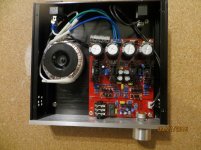
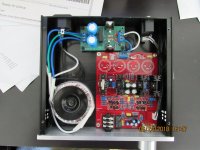
The good news is it works and the hum is greatly reduced to almost inaudible level. The bad news is the hum is still barely noticeable. But it is so low that I can ignore it. It took me only 2 years to finish this project. In between, I retired from my day job and moved from St. Louis to Chicago.
The sound driving a Sennheiser HD-600 is wonderful with a good depth of the sound stage. It is particularly good when listening to symphonic music where the orchestra is projected in front of me, not in the head. The regulated PS also give a more authoritative bass. The overall sound is very open and similar to the unmodified board.
The quality of the E19 PCB turned out to be very good with dual surface trace and plated through holes. It was a real struggle to removed the 4 6800uF main filter capacitors. The headphone amp did not work when I put it back together the first time. I eventually found that one of the plated through hole was damaged and cut off the 12V supply to the protection relay. I added an extra jumper and everything are fine.
One side note on the L7815/L7915 regulators. I purchased 10 of each with the intention of selecting the best matched pair. Alas, the L7815/L7915 are 0.4 volt apart on the average. The lowest 7815 output is 0.2 volt higher than the highest 7915. Fortunately, the E19 seems to have very good CMRR. Despite the unbalanced PS, the output DC offset is only 1 mV on one channel and 9 mV on the other without trimming.
The schematic of the PS that I used. It is a kit PS that I have idle on my work bench for many years.
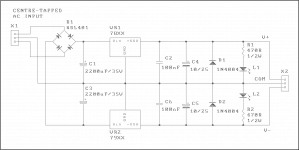
The E19 board has very well designed amplifier topology. The circuit board construction is very good. But the ground loop in the PCB layout is terrible as nattawa pointed out earlier.
Last edited:
- Status
- This old topic is closed. If you want to reopen this topic, contact a moderator using the "Report Post" button.
- Home
- Amplifiers
- Headphone Systems
- E19 headphone amplifier board K2381 J407 MOSFET Yuanjing Audio
